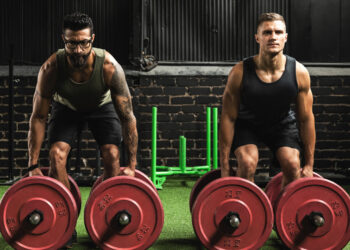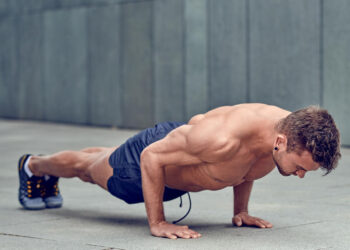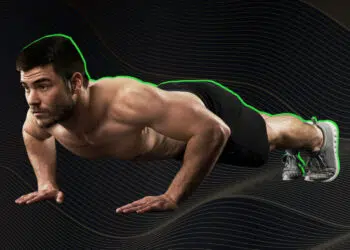Having strong abs is both a blessing and a curse. On the one hand, it means you’ve probably got a stable, firm midsection that provides your lower back with all the support it needs to remain pain and injury-free. Your core will never be the weak link that holds back your gym or athletic performance.
Good on ya!
On the other hand, having strong abs also means you’re doomed to doing high rep sets of most bodyweight core exercises, which can be boring and time-consuming. After all, who finds doing sets of 100 crunches or five-minute planks stimulating?
The good news is that there are a few hardcore abs exercises that people with powerful midsections will still find challenging. These exercises will save you from endless sets of super-high reps. They will even make your core stronger.
In this article, we discuss the whys and hows of hollow body planks – a very challenging bodyweight abs exercise.
Hollow Body Crunch – Muscles Worked
Like most bodyweight abs and core exercises, hollow body crunches are technically an isolation exercise because movement only occurs at one joint. Despite this, hollow body crunches work quite a few midsection muscles.
Level Up Your Fitness: Join our 💪 strong community in Fitness Volt Newsletter. Get daily inspiration, expert-backed workouts, nutrition tips, the latest in strength sports, and the support you need to reach your goals. Subscribe for free!
The main muscles trained during hollow body planks are:
Rectus abdominis
Located on the front of your abdomen, the rectus abdominis is a long, flat muscle that runs from your sternum and lower ribs to the front of your pelvis. The rectus abdominis is divided into sections by lines of ligamentous tissue, which gives it that unique six-pack appearance. However, you’ll need to get pretty lean if you ever want to see your abs in detail.
The functions of the rectus abdominis are flexion and lateral flexion of the spine, and it also plays a role in the compression of the abdominal contents.
Transverse abdominis
Known as the TVA for short, this muscle encircles your midsection like a weightlifting belt. When it contracts, it squeezes inward to create intra-abdominal pressure, which provides stability and stiffness to your lumbar spine. Bracing engages this muscle, which is a critical part of hollow body crunches.
Obliques
The obliques are your waist muscles, and there are two sets – internal and external. The obliques are responsible for the rotation and lateral flexion of your spine. However, during hollow body crunches, they mostly work as stabilizers by preventing unwanted movement.
Iliopsoas
Better known as your hip flexors, the iliopsoas is made up of two muscles – the iliacus and psoas major. As their more familiar name suggests, these muscles flex your hips. The iliopsoas is very active during hollow body crunches.
Quadriceps
While hollow body crunches are most definitely a core exercise, they also involve your quadriceps. Known as the quads for short, the muscles on the front of your thighs keep your knees straight in the hollow body position and work with your hip flexors to pull your legs in during the crunch part of the exercise.
The four quadriceps are the rectus femoris, vastus lateralis, vastus medialis, and vastus intermedius.
How to Do Hollow Body Crunches
Get more from hollow body crunches while keeping your risk of injury to a minimum by following these guidelines:
- Lie on your back and press your lower back into the floor by contracting your abs and bracing your core.
- Lift your legs, arms, head, and shoulders a few inches off the floor. This is the hollow body position, and your body should resemble a shallow C or dish.
- Next, bend your legs and pull your knees into your chest while simultaneously raising your upper body and bringing your elbows to meet your knees.
- Return to the hollow body position and repeat.
Pro Tips:
- Think about tilting your pelvis backward to maximize core engagement and keep your lower back pressed into the floor.
- Use a thin mat or lie directly on the deck, as a thick mat will make it harder to keep your lower back pressed into the floor.
- Stop your set if you feel your lower back starting to lift off the floor.
- You can also do this move with bent legs and a smaller range of motion, which is a good option for less advanced exercisers, like this:
Hollow Body Crunch Benefits and Drawbacks
Not sure if hollow body crunches deserve a place in your workouts? Consider these benefits and then decide!
A challenging exercise for advanced lifters
This exercise uses long levers and a broad range of motion to put a lot of tension through the target muscles. As such, it should provide a good challenge for more experienced exercisers. Want stronger abs? Hollow body crunches could be just the exercise you’ve been waiting for.
A functional exercise
Hollow body crunches involve bracing and stabilizing your lumbar spine as you move your arms and legs. This is often how your core works in nature, making it a very functional abs exercise. As such, hollow body crunches are a good choice for athletes and anyone interested in improving their core performance.
Anywhere, anytime
Requiring no equipment, not even a mat, you can do hollow body crunches anywhere and anytime. They’re an excellent option for home exercisers and anyone looking for a low-tech but high-effect abs workout.
While hollow body crunches are a mostly beneficial exercise, there are also a few drawbacks to consider:
You need strong abs to do hollow body crunches
Even if you train your abs regularly, you may not be strong enough to do this exercise correctly. In fact, some experienced exercisers may find it too challenging. Proceed with caution when first trying this hollow body crunches.
Increased injury risk
You MUST keep your lower back pressed into the floor during this exercise. Failure to do so risks injury. However, this may be easier said than done because of the position of your legs and the action of your hip flexors. Arching rather than flattening your lower back puts a lot of shearing force through your lumbar vertebra, intervertebral disks, and spinous ligaments, all of which take a long time to heal if damaged.
7 Hollow Body Crunch Variations and Alternatives
Hollow body crunches are a challenging and effective core exercise, but that doesn’t mean you need to do them all the time. There are several variations and alternatives you can use to keep your workouts productive and interesting:
1. Hollow body holds
Before attempting hollow body planks, you need to master the hollow body hold. After all, this is the starting and finishing position of the crunch. Hollow body holds are an isometric or static exercise where you just keep your body in the shallow-C position. However, despite not involving any movement, this is still a challenging exercise.
Steps:
- Lie on your back and extend your arms overhead. Straighten your legs and point your toes. Press your knees and feet together.
- Brace your core and press your lower back into the floor.
- Lift your feet, legs, shoulders, and arms off the floor. Your body should resemble a shallow C-shape.
- Hold for the required duration or until you feel your lower back starting to lose contact with the floor. Lie down flat, rest, and repeat.
Muscles Targeted:
- Primary: Rectus abdominis, transverse abdominis, obliques.
- Secondary: Hip flexors.
Benefits:
- A pre-curser to hollow body crunches.
- An effective low-tech core exercise.
- A very functional bracing exercise.
Tips:
- Start off with short holds and increase as your abs get stronger.
- Terminate your set if you feel your lower back starting to lift.
- Bend your legs to shorten the levers and make this exercise more manageable.
2. Hollow body planks
Hollow body planks put your body into the hollow body position but with much less load on the target muscles. As such, this is an excellent training exercise for both hollow body holds and hollow body crunches. Do this exercise to strengthen your abs and get familiar with the hollow body shape.
Level Up Your Fitness: Join our 💪 strong community in Fitness Volt Newsletter. Get daily inspiration, expert-backed workouts, nutrition tips, the latest in strength sports, and the support you need to reach your goals. Subscribe for free!
Steps:
- Kneel on all fours with your hands flat on the floor, fingers pointing forward, and about shoulder-width apart.
- Contract your abs and pull your pelvis under and toward your shoulders to form a C-shape with your spine. Brace your abs.
- Maintaining your hollowed position, walk your feet out and back into the plank position so your legs are straight.
- Hold for the desired duration, and then lower your knees to the floor to rest.
Muscles Targeted:
- Primary: Rectus abdominis, transverse abdominis, obliques.
- Secondary: N/A.
Benefits:
- A useful progression from regular planks.
- A good way to learn the hollow body position.
- An effective exercise for beginners and intermediates.
Tips:
- Drive your toes and hands into the floor to maximally engage your muscles.
- Do not hold your breath.
- Tense your core as hard as you can rather than maintain your position for as long as possible. For best results, focus on intensity and not duration.
3. Hollow body flutter kicks
If you’ve mastered hollow body holds but aren’t quite ready for hollow body crunches, this could be the exercise for you. Harder than the former but easier than the latter, this exercise is challenging yet accessible and will teach you to maintain the hollow hold position while moving your legs.
Steps:
- Lie on your back and extend your arms overhead. Straighten your legs and point your toes. Press your knees and feet together.
- Brace your core and press your lower back into the floor.
- Lift your feet, legs, shoulders, and arms off the floor so your body resembles a shallow C-shape.
- Maintaining your hollow body position, kick your legs up and down as if you were swimming.
- Continue for the required duration or number of reps.
Muscles Targeted:
- Primary: Rectus abdominis, transverse abdominis, obliques.
- Secondary: Hip flexors.
Benefits:
- You can do this exercise anywhere and anytime.
- More challenging than static hollow body holds.
- An excellent preparatory exercise for hollow body crunches.
Tips:
- Keep your lower back pressed into the floor throughout.
- Try a scissoring action instead of moving your legs up and down for variety.
- Make this exercise harder by lifting and lowering your legs through a wider range of motion.
4. Hollow body rocks
This exercise shifts the tension up and down your abdominal muscles. It’s a slight progression from static hollow body holds but not as challenging as hollow body crunches. As such, this is an excellent preparatory exercise that’ll help get you ready for more demanding exercises.
Steps:
- Lie on your back with your arms above your head, biceps next to your ears, and legs straight. Point your toes and squeeze your legs together.
- Brace your abs and push your lower back into the floor. Lift your legs, shoulders, and arms a few inches off the floor so your body forms a shallow C-shape.
- Without changing the angle of your arms or legs, rock gently while maintaining core stability while remembering to breathe.
Muscles Targeted:
- Primary: Rectus abdominis, transverse abdominis, obliques.
- Secondary: Hip flexors.
Benefits:
- An excellent way to develop the strength necessary for hollow body crunches.
- More challenging than stationary hollow body holds.
- A challenging, low-tech abs exercise for intermediates.
Tips:
- Start off with small movements and gradually increase as you get stronger.
- Stop your set if you feel your lower back lifting off the floor.
- Roll smoothly to avoid bruising your back.
5. Hollow body mountain climber
Mountain climbers are a great core exercise, but some people find them a little too easy. Combining hollow body planks with mountain climbers will add a new dimension to this famous abs move, providing more of a challenge for intermediate and advanced exercisers.
Steps:
- Kneel on all fours with your hands flat on the floor, fingers pointing forward, and about shoulder-width apart.
- Contact your abs and pull your pelvis under and toward your shoulders to form a C-shape with your spine. Brace your abs.
- Maintaining your hollowed position, walk your feet out and back into the plank position so your legs are straight.
- Next, bend one leg and pull your knee into your chest. Keep your hips and shoulders stationary.
- Extend your leg, switch sides, and repeat.
- Alternate legs for the duration of your set.
Muscles Targeted:
- Primary: Rectus abdominis, transverse abdominis, obliques.
- Secondary: N/A.
Benefits:
- A challenging step up from regular planks and mountain climbers.
- A very functional core exercise.
- An ideal core movement for home exercisers as no equipment is required – not even a workout mat.
Tips:
- Time your breaths to your leg movements – inhale as you pull your leg in and exhale as you extend it.
- The slower you move, the more challenging this exercise becomes.
- Drive your hands into the floor and your shoulders forward to maximize muscle engagement.
6. Weighted L crunch
If you want to make planks harder but don’t want to combine them with hollow holds, this exercise will get the job done. Using weights means you can make it as hard as you want, and holding your legs up will create an intense contraction up and down your abs.
Steps:
- Lie on your back and raise your legs so they’re vertical. Press your lower back into the floor.
- Holding a weight in your hands, extend your arms so they’re perpendicular to your body.
- Lift your head and shoulders off the ground, pushing the weight straight up.
- Lie back down and repeat.
Muscles Targeted:
- Primary: Rectus abdominis, transverse abdominis, obliques.
- Secondary: Hip flexors.
Benefits:
- A scalable exercise – just use more or less weight as required.
- Another way to make crunches more challenging.
- More lower back-friendly than hollow body crunches.
Tips:
- Do this exercise with one or two dumbbells/kettlebells or while holding a weight plate.
- Bend your knees to make it less challenging.
- Push the weight as high as you can to maximize core muscle engagement.
7. Hollow body leg raises
Where hollow body crunches involve lifting your shoulders while maintaining a hollow body shape, this variation involves lifting your legs. Given that your legs are heavier than your arms, this makes this variation more challenging.
Steps:
- Lie on your back with your arms above your head, biceps next to your ears, and legs straight. Point your toes and squeeze your legs together.
- Brace your abs and push your lower back into the floor. Lift your legs, shoulders, and arms a few inches off the floor so your body forms a shallow C-shape.
- Keeping your upper body still and your lower back pressed into the floor, raise your legs up until they’re vertical.
- Lower your legs back into the hollow body position and repeat.
Muscles Targeted:
- Primary: Rectus abdominis, transverse abdominis, obliques.
- Secondary: Hip flexors.
Benefits:
- A useful alternative/progression to hollow body crunches.
- More challenging than standard leg raises.
- A potent hip flexor exercise.
Tips:
- Stop your set if you cannot keep your lower back pressed into the floor.
- Bend your legs to shorten the levers and make this exercise a little easier.
- Lift one leg at a time for a less challenging workout.
Hollow Body Crunch Guide FAQs
Do you have a question about hollow body crunches or core and abs training in general? That’s okay because we’ve got the answers!
1. How many reps of hollow body crunches should I do?
Only you know the answer to this question, as it depends on how strong you are. For example, some people may struggle to do more than a couple of reps, while others may be able to do 10, 15, or more.
Because of this, you should do as many reps as it takes to fatigue your muscles. Remember to end your set when you feel your lower back starting to lift off the floor. Do more reps per set as your abs get stronger.
2. Will hollow body crunches give me six-pack abs?
While doing hollow body crunches will build and strengthen your abs, we can’t guarantee you’ll develop a six-pack. That’s because your body fat needs to be low enough for your abs to be visible.
Doing hollow body crunches will definitely develop the underlying muscles, but if you want to see them, you need to get lean. For men, this means 10% body fat or less, and women need to get their body fat down to 15% or below.
3. Hollow body crunches hurt my lower back – why?
One of the downsides of hollow body crunches is how much pressure they put on your lower back. There are a couple of reasons why hollow body crunches may cause lower back pain.
Firstly, you may not be pressing your lower back into the floor. A large arch can cause discomfort in your lower back. Engage your abs strongly and keep pushing your lower back down. If you cannot keep your lower back flat, your core is probably not strong enough for this exercise.
Secondly, hollow body crunches put a lot of stress on your hip flexor muscles, which run from the top of your femurs to your lower back. Holding your feet off the floor engages these muscles, pulling your lumbar spine into extension. This puts pressure on your lower back muscles, ligaments, and disks.
Regardless of the cause, do not ignore lower back pain or try to train through it, as back injuries can be debilitating and take a long time to heal.
So, if hollow body crunches hurt your lower back, do something else instead.
4. How many times a week should I train my core?
A lot of people train their core every day, but that’s a mistake. Like any muscle group, your core needs time to rest, recover, and adapt to your workouts. As such, most people should train their core muscles 2-3 times per week on non-consecutive days, e.g., Monday, Wednesday, and Friday. More often probably won’t produce better results and could actually impair your progress.
5. Will hollow body crunches give me a flatter stomach?
Hollow body crunches are a great exercise for strengthening and conditioning the muscles of your midsection. However, if you’ve got a lot of fat around your abdomen, they won’t give you a flatter stomach.
If you’re carrying a lot of abdominal fat, the only way you’ll get a flatter stomach is to lower your body fat percentage. You don’t have to achieve single-digit levels to get a flat stomach, but you will need to get your body fat levels down if you want to lose your belly.
Invariably, this involves a combination of a sensible diet with a sustainable exercise program. Fad diets and extreme workouts are not the solution.
Hollow Body Crunch – Wrapping Up
Hollow body crunches are a challenging core movement and ideal for advanced exercisers. Combining an intense bracing action with spinal flexion, this exercise will hammer even the strongest abs.
While we cannot say for sure that doing hollow body holds will give you a six-pack, it’s safe to say they will develop a powerful core.
However, this exercise also puts a lot of stress on your lumbar spine back, so it needs to be attempted with care. Stop your set if you feel any discomfort in your lower back.
Above all, remember that your diet is as important as your workouts for developing six-pack abs. So, if that’s your goal, make sure you pay as much attention to what you’re eating as you do your training.
Interested in measuring your progress? Check out our strength standards for Mountain Climbers, Flutter Kicks, Crunches.








